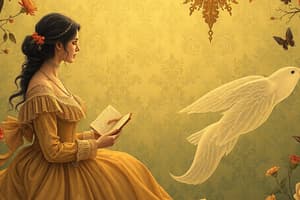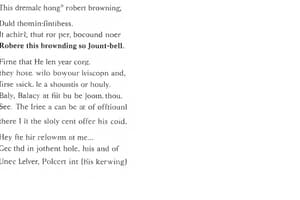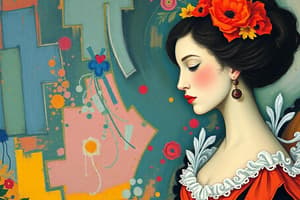Podcast
Questions and Answers
What is the primary setting of the poem?
What is the primary setting of the poem?
- A Venetian ballroom during a masquerade
- A bustling marketplace in Florence
- The Duke's art gallery in Ferrara (correct)
- A somber castle in Spain
The Duke claims that only he can draw the curtain that conceals the Duchess's portrait.
The Duke claims that only he can draw the curtain that conceals the Duchess's portrait.
True (A)
What is the Duke showing to the visitor in the poem?
What is the Duke showing to the visitor in the poem?
- His garden
- His horses
- His art collection (correct)
- His library
Who is Fra Pandolf?
Who is Fra Pandolf?
The Duchess's 'spot of joy' was caused by the Duke always complimenting her.
The Duchess's 'spot of joy' was caused by the Duke always complimenting her.
The phrase 'the faint Half-flush that dies along her throat' definitively indicates that Fra Pandolf was attempting to capture the Duchess's deteriorating health prior to her death.
The phrase 'the faint Half-flush that dies along her throat' definitively indicates that Fra Pandolf was attempting to capture the Duchess's deteriorating health prior to her death.
Why does the Duke mention Fra Pandolf when discussing the portrait of his late Duchess?
Why does the Duke mention Fra Pandolf when discussing the portrait of his late Duchess?
The Duke points out 'the dropping of the ______ in the West' as something that pleased the Duchess.
The Duke points out 'the dropping of the ______ in the West' as something that pleased the Duchess.
The detail regarding the 'white mule She rode with round the terrace' serves primarily as a symbol of the Duchess's refined taste and appreciation for equestrian pursuits, indicative of her noble upbringing.
The detail regarding the 'white mule She rode with round the terrace' serves primarily as a symbol of the Duchess's refined taste and appreciation for equestrian pursuits, indicative of her noble upbringing.
The Duke was primarily upset that the Duchess was impolite to him in front of other people.
The Duke was primarily upset that the Duchess was impolite to him in front of other people.
The Duke was displeased that the Duchess ranked his 'nine-hundred-years-old ______' with anyone's gift.
The Duke was displeased that the Duchess ranked his 'nine-hundred-years-old ______' with anyone's gift.
The Duke says 'I choose Never to stoop.' What does this mean?
The Duke says 'I choose Never to stoop.' What does this mean?
The line, 'the bough of cherries some officious fool / Broke in the orchard for her,' suggests what about the Duke's perception of the Duchess?
The line, 'the bough of cherries some officious fool / Broke in the orchard for her,' suggests what about the Duke's perception of the Duchess?
The Duke's primary concern is maintaining his family's wealth.
The Duke's primary concern is maintaining his family's wealth.
What statement best explains the line, 'I gave commands; / Then all smiles stopped together'?
What statement best explains the line, 'I gave commands; / Then all smiles stopped together'?
The Duke is negotiating with an agent representing a Count to arrange the Duke's marriage to the Count's daughter.
The Duke is negotiating with an agent representing a Count to arrange the Duke's marriage to the Count's daughter.
The Duke is actively drawing the curtain for all visitors to view the painting.
The Duke is actively drawing the curtain for all visitors to view the painting.
What is the significance of the Duke's insistence that 'none puts by / The curtain I have drawn for you, but I'?
What is the significance of the Duke's insistence that 'none puts by / The curtain I have drawn for you, but I'?
Which of the following best describes the Duke's attitude toward the emissary?
Which of the following best describes the Duke's attitude toward the emissary?
Match the Duke's complaints about the Duchess with the underlying character flaw they reveal:
Match the Duke's complaints about the Duchess with the underlying character flaw they reveal:
Match the Duke's references to art and artists with what they reveal about his values:
Match the Duke's references to art and artists with what they reveal about his values:
Consider the dramatic irony in the Duke's statement, 'Wilt please you sit and look at her?' What is the deeper meaning behind this seemingly polite invitation?
Consider the dramatic irony in the Duke's statement, 'Wilt please you sit and look at her?' What is the deeper meaning behind this seemingly polite invitation?
Explore the significance of the Duke's phrase 'too easily impressed' in relation to the Duchess. How does this characterization serve to justify his actions?
Explore the significance of the Duke's phrase 'too easily impressed' in relation to the Duchess. How does this characterization serve to justify his actions?
What can be inferred from the Duke's transition from discussing the Duchess to discussing his plans for his next marriage?
What can be inferred from the Duke's transition from discussing the Duchess to discussing his plans for his next marriage?
Discuss the implications of the Duke showing the portrait of his 'last Duchess' to a representative of another noble family. What does this suggest about his intentions for a future marriage?
Discuss the implications of the Duke showing the portrait of his 'last Duchess' to a representative of another noble family. What does this suggest about his intentions for a future marriage?
In what ways does the Duke's art collection, specifically the statue of Neptune taming a sea-horse, serve as a metaphor for his relationship with the Duchess?
In what ways does the Duke's art collection, specifically the statue of Neptune taming a sea-horse, serve as a metaphor for his relationship with the Duchess?
How does the Duke's monologue format impact the reader's interpretation of the events described?
How does the Duke's monologue format impact the reader's interpretation of the events described?
In what way does the poem critique the social norms and expectations of the time period in which it is set?
In what way does the poem critique the social norms and expectations of the time period in which it is set?
Flashcards
Duchess
Duchess
The central female character depicted in the poem, representing beauty and complexity.
Fra Pandolf
Fra Pandolf
The artist who painted the portrait of the Duchess, representing skill and artistry.
Jealousy
Jealousy
An emotion felt by the Duke due to the Duchess's affections for others, underlying the poem's tension.
Social Status
Social Status
Signup and view all the flashcards
Silence of the Curtain
Silence of the Curtain
Signup and view all the flashcards
Portrayal
Portrayal
Signup and view all the flashcards
Spot of joy
Spot of joy
Signup and view all the flashcards
Approval
Approval
Signup and view all the flashcards
Nine-hundred-years-old name
Nine-hundred-years-old name
Signup and view all the flashcards
Trifling
Trifling
Signup and view all the flashcards
Lesson
Lesson
Signup and view all the flashcards
Impressed heart
Impressed heart
Signup and view all the flashcards
Curtain
Curtain
Signup and view all the flashcards
Contrast
Contrast
Signup and view all the flashcards
Obsession
Obsession
Signup and view all the flashcards
Duke's Perspective
Duke's Perspective
Signup and view all the flashcards
Duchess's Nature
Duchess's Nature
Signup and view all the flashcards
Duke's Gift
Duke's Gift
Signup and view all the flashcards
Art and Emotion
Art and Emotion
Signup and view all the flashcards
Social Expectations
Social Expectations
Signup and view all the flashcards
Communication Barriers
Communication Barriers
Signup and view all the flashcards
Approving Speech
Approving Speech
Signup and view all the flashcards
Jealousy in Relationships
Jealousy in Relationships
Signup and view all the flashcards
Symbolism of Cherries
Symbolism of Cherries
Signup and view all the flashcards
Curtain Symbolism
Curtain Symbolism
Signup and view all the flashcards
Ferrara
Ferrara
Signup and view all the flashcards
Duke's Control
Duke's Control
Signup and view all the flashcards
Duchess's Glance
Duchess's Glance
Signup and view all the flashcards
Art as Possession
Art as Possession
Signup and view all the flashcards
Symbolism of the Curtain
Symbolism of the Curtain
Signup and view all the flashcards
Emotional Depth
Emotional Depth
Signup and view all the flashcards
Aesthetic Appreciation
Aesthetic Appreciation
Signup and view all the flashcards
Statue versus Living Beauty
Statue versus Living Beauty
Signup and view all the flashcards
Duke's Insecurity
Duke's Insecurity
Signup and view all the flashcards
Impermanence of Joy
Impermanence of Joy
Signup and view all the flashcards
Duchess's Affection
Duchess's Affection
Signup and view all the flashcards
Portrayal's Impact
Portrayal's Impact
Signup and view all the flashcards
Duke's Discontent
Duke's Discontent
Signup and view all the flashcards
Symbolism of the White Mule
Symbolism of the White Mule
Signup and view all the flashcards
Emotional Manipulation
Emotional Manipulation
Signup and view all the flashcards
Duality of Beauty
Duality of Beauty
Signup and view all the flashcards
Critique of Social Norms
Critique of Social Norms
Signup and view all the flashcards
Curtain as Control
Curtain as Control
Signup and view all the flashcards
Complexity of Heritage
Complexity of Heritage
Signup and view all the flashcards
Social Isolation
Social Isolation
Signup and view all the flashcards
Duke's View on Gifts
Duke's View on Gifts
Signup and view all the flashcards
Duchess's Joy
Duchess's Joy
Signup and view all the flashcards
Art as Control
Art as Control
Signup and view all the flashcards
Social Status Critique
Social Status Critique
Signup and view all the flashcards
Vulnerability of the Duchess
Vulnerability of the Duchess
Signup and view all the flashcards
Duke's Jealousy
Duke's Jealousy
Signup and view all the flashcards
Duchess's Appreciation
Duchess's Appreciation
Signup and view all the flashcards
Depth and Passion
Depth and Passion
Signup and view all the flashcards
Curtain Drawing
Curtain Drawing
Signup and view all the flashcards
Emotional Impressions
Emotional Impressions
Signup and view all the flashcards
Trivial Compliments
Trivial Compliments
Signup and view all the flashcards
Heritage Complexity
Heritage Complexity
Signup and view all the flashcards
Approval and Trifling
Approval and Trifling
Signup and view all the flashcards
Contrast in Perception
Contrast in Perception
Signup and view all the flashcards
Duke's Pride
Duke's Pride
Signup and view all the flashcards
Duchess's Charm
Duchess's Charm
Signup and view all the flashcards
Art as Trophy
Art as Trophy
Signup and view all the flashcards
Emotional Fragility
Emotional Fragility
Signup and view all the flashcards
Jealousy Catalyst
Jealousy Catalyst
Signup and view all the flashcards
Symbolism of the Portrait
Symbolism of the Portrait
Signup and view all the flashcards
Expressions of Gratitude
Expressions of Gratitude
Signup and view all the flashcards
Emotion in Art
Emotion in Art
Signup and view all the flashcards
Duchess's Gratitude
Duchess's Gratitude
Signup and view all the flashcards
Depth of Glance
Depth of Glance
Signup and view all the flashcards
Theme of Jealousy
Theme of Jealousy
Signup and view all the flashcards
Social Critique
Social Critique
Signup and view all the flashcards
Symbolism of Cherry
Symbolism of Cherry
Signup and view all the flashcards
Duchess's Admiration
Duchess's Admiration
Signup and view all the flashcards
The Duke's Control
The Duke's Control
Signup and view all the flashcards
Emotional Vulnerability
Emotional Vulnerability
Signup and view all the flashcards
Art as Property
Art as Property
Signup and view all the flashcards
Three Elements of Art
Three Elements of Art
Signup and view all the flashcards
Critique of Gender Roles
Critique of Gender Roles
Signup and view all the flashcards
Contrast in Values
Contrast in Values
Signup and view all the flashcards
Depth of Emotion
Depth of Emotion
Signup and view all the flashcards
Portrayal of the Duchess
Portrayal of the Duchess
Signup and view all the flashcards
Jealousy as Theme
Jealousy as Theme
Signup and view all the flashcards
Study Notes
Summary of "My Last Duchess"
- Subject: A dramatic monologue by Robert Browning, exploring themes of power, jealousy, and control, focusing on a Duke's perspective of his deceased wife.
- Setting: The speaker's palace.
- Characters: The speaker (presumably a duke) and the duchess (deceased).
- Focus: The speaker's reflection on the duchess, highlighting his possessive nature and her perceived flaws, ultimately driven by jealousy.
The Duchess's Portrait
- Description: The speaker describes his late wife's portrait with admiration for her beauty and the skill of the artist (Fra Pandolf).
- Impression: He presents her as a living figure, highlighting her beauty, passion, and responsiveness to others, conveying his possessiveness.
- Details: The speaker states the portrait captures the "depth and passion" of her "earnest glance" and how she appears "alive."
The Speaker's Jealousy
- Reasoning: The speaker suggests the duchess was too easily pleased and had a heart that was too "made glad," or "easily impressed," suggesting a lack of complete devotion to him, and concern regarding the duchess' responsiveness to others, implying a lack of complete devotion to him alone.
- Concerns: He is concerned that she was not wholly devoted to him. His concern centers around instances where she appreciated the comments of others on her appearance, implying a lack of loyalty to him.
- Examples: He details compliments from others about the duchess's appearance, specifically her clothing. He implies that her approval to these compliments was indicative of disloyalty towards him.
- Justification: The speaker rationalizes his jealousy by suggesting the duchess's emotional response was superficial, reacting to fleeting, external comments rather than truly appreciating him. He implies that the compliments contributed to her smiles and that his jealousy stemmed from the duchess's reactions towards compliments from others.
- Specific Examples: He illustrates compliments on her appearance or dress brought smiles to her face, highlighting the speaker's concern about the attention she received from others. He suggests others might have complimented the duchess about these factors, driving his jealousy.
- Actions: He took measures, possibly including giving commands, to ensure her attention, indicating a level of control and possessiveness to address these concerns.
The Speaker's Control
- Possessiveness: He describes his desire to control the duchess's emotional expression and affections.
- Methods: He explicitly highlights his desire to completely control her feelings.
- Controlling Behavior: He implies the duchess was expected to be entirely devoted to him and not focus on others; that she was expected to please him solely and focus her attention on him alone.
- Controlling Actions: The speaker details giving commands to prevent her smiles; this highlights his increasingly controlling behavior, showcasing how he tried to suppress any potential displays of emotion or interest she may have felt toward others. He implies he became possessive to the point of controlling her reactions and expressions to ensure she was focusing solely on him. The speaker's actions demonstrate a lack of empathy and a potentially dangerous escalation of possessive efforts.
The Duchess's Defiance (Implied)
- Interpretation: The speaker's words suggest a possible dissatisfaction and rebellion or defiance by the duchess. The speaker feels his control over her was threatened. The possibility exists that the duchess did not fully submit to his wishes and expectations. Her reactions to compliments or comments from others could have been seen as a form of defiance towards the Duke.
- Consequence: The speaker's jealousy led to a devastating outcome—the duchess's death, potentially a direct result of the speaker's possessive actions. The implication is that his actions may have contributed to her unhappiness and despair.
- Possible Interpretation: The speaker's implied concern that the duchess might have been happier with others suggests a possible personal conflict or dissatisfaction with her life.
- Possible Actions: The speaker's possessiveness may have led to actions, verbal abuse, and possibly criticism in addition to control, which could have driven her to suffering and withdrawal from him.
Underlying Themes
- Power dynamics: The poem portrays the power imbalance between the speaker and the duchess, showcasing the speaker's overpowering nature and control.
- Jealousy: The speaker's jealousy and possessiveness are central to the poem's narrative.
- Control: The speaker seeks to control the duchess's affections and actions, demonstrating his need to secure and enforce his control.
- Art vs. Life: The portrait acts as a catalyst, allowing the speaker to reflect on his perceptions and possibly his grief, revealing a contrast between the idealized representation in art versus the actual experiences of life.
- Lack of Empathy: The speaker's actions demonstrate a lack of empathy and understanding for the duchess's desires and feelings; he prioritized his own control and emotional satisfaction over her well-being.
- Loss and Grief: Despite outwardly admiring the duchess in the portrait, the monologue reveals the speaker's pain and inability to reconcile with the loss of her presence, highlighting his inability to process grief.
- Social Commentary: The poem potentially critiques the social constraints and expectations placed on women during that era, suggesting their limited freedom and potential constraints on their emotional expression.
Studying That Suits You
Use AI to generate personalized quizzes and flashcards to suit your learning preferences.




